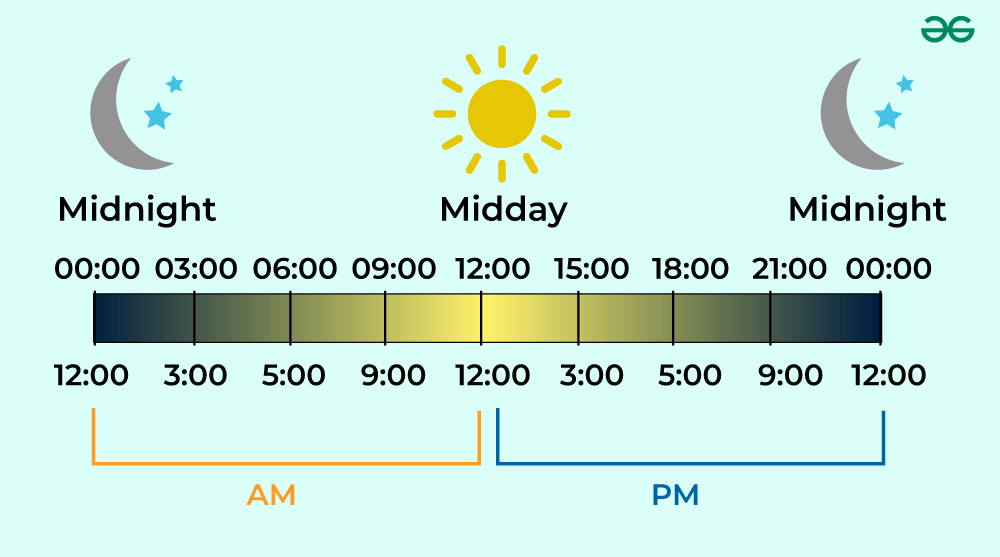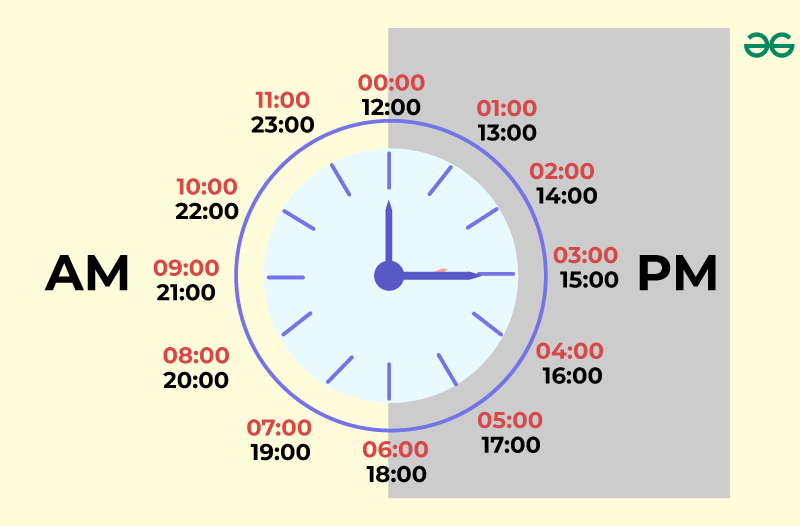AM and PM Full Form
Last Updated :
21 Mar, 2024
AM and PM Full Form: Whenever we see what time it is or need to tell anybody about the time, we often use terms like AM & PM, which are Latin words. But we don’t know the meaning of these terms. AM is used for the first 12 hours of a day & PM for the next twelve hours a day. While AM means the time from midnight to 11:59 noon & PM means the time from 12 noon to 11:59 midnight. AM which is the initial 12-hour period, lasts from midnight to noon while PM- the next 12-hour period, lasts from noon to midnight.

AM and PM
The full form of AM is Ante-Meridiem. AM a Latin term, indicates a 12-hour clock system before Noon. AM means before midday. It is a unit of the time standard, related to the 12-hour clock system that splits a day’s time cycle into two parts. AM or Ante Meridiem refers to the first period. AM describes the midnight to noontime.
The full form of PM is Post Meridiem. PM denotes the post-midday period. It is also associated with the 12-hour clock system which splits the period into two equal periods. PM reflects the second period & refers to the time from Noon to midnight.
AM means before midday. It is a unit of the time standard, related with the 12-hour clock system which splits a day’s time cycle into two parts. AM or Ante Meridiem refers to the first period. AM describes the midnight to noontime.
PM means Post Meridiem which denotes the post-midday period. It is also associated with the 12-hour clock system which splits the period into two equal periods. PM reflects the second period & refers to the time from Noon to midnight.
Use of AM and PM
There are two formats of clocks, i.e., the 12-hour clock format and the 24-hour clock format. A day is made up of 24 hours, therefore time can be easily told in the 24-hour format without using any unit. However, in a 12 hours format, each number is repeated twice a day.
It is not much of an issue telling the current time as we know whether it’s day or night. However, when we need to document something which will take place for future reference, one must mention whether it’s 1 o’clock at night or 1 o’clock in the afternoon. Here, the a.m. and p.m. units come into use.

Difference of AM and PM
Examples of AM and PM
When we hear someone saying that they are coming at 8 o’clock, it’s confusing that morning or evening. In the 12-hour clock, system AM & PM are used to prevent this confusion. So, the morning is 8 am & evening is 8 pm.
Some keywords to remember
AM = Ante (before) Meridiem (midday)
PM = Post (represents after) Meridiem (midday)
Origin of AM and PM
Abbreviations AM & PM, which are Latin phrases do not expand into full English forms. AM- ”ante meridiem” (before midday) & PM- “post meridiem” (after midday)
All the hours starting from 12 at the start of a new day to the noon of that day are followed by AM & all the hours after 12 o’clock noon are followed by the unit PM. These units became popular around the 17th century AD.
Origin of AM
AM means Ante-Meridiem. AM a Latin term, indicates a 12-hour clock system before Noon. AM means before midday. It is a unit of the time standard, related to the 12-hour clock system that splits a day’s time cycle into two parts. AM or Ante Meridiem refers to the first period. AM describes the midnight to noontime.
Origin of PM
PM means Post Meridiem which denotes the post-midday period. It is also associated with the 12-hour clock system which splits the period into two equal periods. PM reflects the second period & refers to the time from Noon to midnight.
Need for AM and PM
The abbreviations AM & PM came into being in the first place because of the 12-hour clock format. Based on the day, two cycles are there:- day & night time. Each of these cycles consists of 12 hours.
A clock system based on these cycles is more convenient rather than using 24 hours to represent all times. In order to implement this, it was felt to distinguish between these two cycles.
This is how AM & PM came into being. Physical clocks are designed on the same concept of two cycles in a day. Hence, only 12 numbers are in a watch even though there are 24 hours in a day. These units aren’t seen in an analog clock. But digital clocks seen in clocks, computers & phones show us time with AM & PM units when set to a 12-hour clock format.
Also Read, Difference Between AM and PM
AM= ante meridiem & PM = post meridiem. These are used in a 12-hour clock format to distinguish the two clock cycles. The hours using AM are from the start of the day until noon. The hours using PM start from noon until the day ends. To convert 24-hour timings into a 12-hour format using AM & PM, one needs to subtract 12 from numbers higher than 12. Physical clocks were designed based on this time format. AM & PM are prominently used today.
1. How to convert 24-hour clock timings into 12-hour clock timing?
How to convert from the 24-hour clock system to the 12-hour clock
- Identify the time you want to convert. Eg: If one has to convert 23:00 to the 12-hour clock system.
- Determine whether the time is AM or PM. If the hours are less than 12, the time is AM. If the hours are 12 or greater, the time is PM. In this case, the time is PM.
- If the time is PM, one can leave the hours as they are. Eg: 22:00 is already 10:00 PM in the 12-hour clock system.
- If the time is AM, one will need to subtract 12 from the hours. Eg: To convert 5:00 AM to the 12-hour clock system, you would subtract 12 from the hours, resulting at 5:00 AM.
- Write the time in the 12-hour clock format. Eg: 22:00 becomes 10:00 PM & 4:00 AM remains 4:00 AM.
2. How to convert 12-hour clock timings into 24-hour clock timings?
How to Convert from the 12-hour clock system (AM/PM) to the 24-hour clock
- Identify the time you want to convert. Example: If we want to convert 8:00 AM to the 24-hour clock system.
- Determine whether the time is AM or PM. The time here is AM.
- If the time is AM, one can leave the hours as they are. Eg: 8:00 AM is already 08:00 in the 24-hour clock system.
- If the time is PM, we need to add 12 to the hours. Eg: if you want to convert 8:00 PM to the 24-hour clock system, you would add 12 to the hours, resulting in 20:00.
- Write the time in the 24-hour clock format. Eg: 8:00 AM becomes 08: 00, and 8:00 PM becomes 20:00.
3. When was the 12-hour clock first invented?
The 12 hour clock was developed in the second millennium BC and in the 16th century, it reached its modern form.
4. Which countries use AM and PM to represent time?
Globally, most of the countries today use the 24-hour system. However, the 12-hour format, including AM & PM, is officially used in a number of countries, like the United States, Canada (except Québec), Australia, New Zealand, & the Philippines.
5. Is the morning time AM or PM?
Morning time is AM. All the hours starting from 12 at the start of a new day to the noon of that day are followed by AM.
6. Is the afternoon 12 AM or PM?
12 PM is noon whereas 12 AM is midnight. And if it refers to noon, it means 12 p.m.
7. Is 12 AM night or day?
12 AM refers to the time of midnight when the clock strikes 12.
8. Is 9 pm at night or evening?
9 PM means “night” for everyone & it also means “evening” for some people. It is not defined as to which are the exact hours that are called “evening”. It differs for various people, depending on the kind of activities they do.
Share your thoughts in the comments
Please Login to comment...